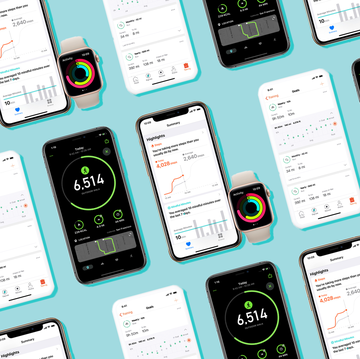One of the most powerful ways to maintain a healthy weight, keep your joints strong, and live longer is also one of the simplest, no matter your age. The health benefits of walking are endless, and experts agree by adding walking to your daily routine, you can greatly improve your physical and mental health.
“Walking has always been my main source of cardio,” says fitness expert Denise Austin.
The key is to strut for, ideally, at least 30 minutes a day, says Melina B. Jampolis, M.D., author of The Doctor on Demand Diet. And whether you decide to lace up your walking shoes and walk to work, pair up with a friend, or join a hiking club, research shows that walking can do everything from lower your blood pressure and reduce your risk of chronic diseases to making your brain sharper and your heart happier.
Walking is simple enough that all fitness levels can get those daily steps in. “It has tremendous benefits, from supporting a healthy immune system to boosting your metabolism to strengthening your joints, muscles, and bones—not to mention it’s amazing for stress relief and enjoying a little ‘me time,’” says Austin.
Meet the experts: Denise Austin, is a fitness expert and author of Denise Austin’s Daily Dozen; Melina B. Jampolis, M.D., is author of The Doctor on Demand Diet; Ariel Iasevoli, an ACE-certified personal trainer in New York City; Michele Stanten, is an ACE-certified fitness instructor, walking coach, and author of Prevention’s Walk Your Way to Better Health, and others.
Ahead, discover the vast benefits of walking, and what you can expect when you start strolling for just a half-hour most days of the week.
Benefits of walking
1. Improve your mood
Going for a walk is an easy fitness strategy that can you feel better, says Dr. Jampolis. In fact, research shows that just 10 minutes of walking can lift your spirits. Plus, the effect may be amplified even more if you take a stroll through some greenery.
“Research shows that regular walking actually modifies your nervous system so much that you’ll experience a decrease in anger and hostility,” Dr. Jampolis says, especially when you’re going for a stroll through some greenery or soaking in a bit of sunlight. This can be particularly helpful during the colder months, when seasonal depression spikes.
Finally, when you make your walks social—you stride with, say, your partner, a neighbor, or a good friend—that interaction helps you feel connected, Dr. Jampolis says, which can make you feel happier.
2. Burn calories and maintain a healthy weight
“As you continue to walk, you may notice your pants begin to fit more loosely around your midsection, even if the number on the scale isn’t moving much,” says Dr. Jampolis. That’s because regular walking can help reduce fat and, as a result, improve your body’s response to insulin, according to research.
Itching to up your calorie burn? When walking outside, plan a route that includes hills, alternate between speed walking and a slower pace, and challenge yourself to walk the same routes on different days to see if you can beat your previous times, says Austin. If you really want to set high goals, she recommends aiming to hit 10,000 steps a day.
“Daily walking increases metabolism by burning extra calories and by preventing muscle loss, which is particularly important as we get older,” says Ariel Iasevoli, a personal trainer in New York City.
The best part? You don’t have to tire yourself out on a treadmill at the gym to see these benefits. “One of my clients reduced her body fat by 2% in just one month by walking home from work each day, which was just under a mile,” she says.
Intervals are key here, says Michele Stanten, a walking coach and author of Prevention’s Walk Your Way to Better Health. Increasing your speed for small bouts of time during, say, a 30-minute walk allows you to burn more calories than if you strolled at a moderate pace for half an hour. This approach also benefits your cardiorespiratory system. To try adding intervals, warm up for three minutes. Then spend 25 minutes alternating between one minute of walking almost as fast as you can go and one minute of brisk walking (aiming for a six on an intensity scale of one to 10). Cool down for two minutes.
3. Improve heart health
One of the major ways that walking can improve your heart health is by lowering your blood pressure. Some research shows that for every 1,000 daily steps you take, you could lower your systolic blood pressure by .45 points. That means if you clock in 10,000 daily steps, your systolic blood pressure is likely to be 2.25 points lower than someone else who walks only 5,000 daily steps.
One of the most cited studies on walking and health, published in The New England Journal of Medicine, found that those who walked enough to meet physical activity guidelines had a 30% lower risk of cardiovascular events (like a heart attack or stroke) compared with those who did not walk regularly. Another study found that especially for older adults, every 500 additional steps taken daily was associated with 14% lower risk of heart disease, stroke or heart failure.
4. Reduce your risk of chronic diseases
A 2022 study published in Nature Medicine has shown that walking can reduce your risk for a variety of chronic diseases. One study showed that walking 8,200 steps effectively reduced the risk of chronic conditions, including: obesity, sleep apnea, gastroesophageal reflux disease (GERD), major depressive disorder (MDD), type 2 diabetes, and hypertension. The same study also found that walking even more steps continues to increase walking’s benefits for nearly every health condition studied.
The American Diabetes Association officially recommends walking to lower blood sugar levels and lower your overall risk for type 2 diabetes. One 2022 study published in Sports Medicine showed specifically that just two minutes of walking after eating can help lower blood sugar. Even the shortest of walks can make a difference.
Still, for disease prevention, longer walks are key. Stanten recommends doing one hour-long walk at least once or twice a week.
5. Reduce your stress
If you’re feeling frazzled or overwhelmed, walking can help lower your stress. Walking reduces the stress hormone cortisol, which helps you feel less stressed and more relaxed, says Joyce Shulman, co-founder and CEO of 99 Walks & Jetti Fitness and author of Walk Your Way to Better.
A 2018 study published in Health Promotion Perspectives showed that just 10 minutes of walking lowers anxiety and depression and increases focus and creativity. Plus, research shows that taking your stroll outside can make a huge difference, too. A 2022 study published in Molecular Psychiatry found that a 60-minute walk in nature decreases activity in brain regions involved in stress processing. In contrast, brain activity in those regions remained stable after a 60-minute walk in an urban environment. So, go touch some grass!
6. Improve your sleep
Working out regularly can help you sleep better at night. That’s because physical activity naturally boosts the effects of melatonin, the sleep hormone. A 2019 study from Sleep found that postmenopausal women who do light to moderate-intensity physical activity snooze better at night than those who are sedentary. Another recent study found healthy adults who walked daily had a significant positive impact on sleep quality and length of sleep. Walking also helps reduce pain and stress, which can cause sleep disturbances.
7. Boost your brainpower
The research here is quickly growing. In one study, brain scans of people who walked briskly for one hour three times a week showed the decision-making areas of their brains worked more efficiently than people who attended education seminars instead. Other research shows physical exercise, like walking, can improve brain function in older women. Experts think these benefits could be due in part to increased blood flow to the brain that occurs with exercise. So when you get your feet moving, your brain starts working better too!
8. Alleviate joint pain
Contrary to what you might think, pounding pavement can help improve your range of motion and mobility because walking increases blood flow to tense areas and helps strengthen the muscles surrounding your joints.
In fact, research shows that walking for at least 10 minutes a day—or about an hour every week—can stave off disability and arthritis pain in older adults. A 2019 study in the American Journal of Preventive Medicine followed 1,564 adults older than 49 with lower-body joint pain. Participants who walked for an hour each week were more likely to remain disability-free four years later. An additional report found that walking was a safe, inexpensive, and convenient physical activity for those with arthritis of all fitness levels.
9. Delay the onset of varicose veins
As you age, your risk of varicose veins increases. However, walking is a proven way to prevent them from developing, says Luis Navarro, M.D., founder and director of The Vein Treatment Center in New York City.
“The venous system includes a circulatory section known as ‘the second heart,’ which is formed by muscles, veins, and valves located in our calf and foot,” he explains. “This system works to push blood back up to the heart and lungs—and walking strengthens this secondary circulatory system by strengthening and preserving leg muscle, which boosts healthy blood flow.”
If you already suffer from varicose veins, daily walking can help ease related swelling and restlessness in your legs, says Dr. Navarro. “Also, if you are genetically predisposed to have varicose and/or spider veins, walking daily can help delay the onset.”
10. Stimulate your digestive system
If you currently count on your daily dose of coffee for keeping your digestive system going strong, get ready to start thanking your morning walk instead. That’s because a regular walking routine can greatly improve your bowel movements, says Tara Alaichamy, D.P.T., the manager of rehabilitation services at Cancer Treatment Centers of America. “One of the very first things an abdominal surgery patient is required to do is to walk because it utilizes core and abdominal muscles, encouraging movement in our GI system,” she says. In other words, when you start moving, your bowels start moving, too.
11. Kickstart your immune system.
Research shows that moderate-intensity exercise—and walking in particular—ramps up our immune system. It increases the number of immune cells that attack pathogens in our body, which may lower your risk of becoming seriously ill from infectious diseases. Not only that, if you do get sick, research has found that people who walk more spend less time in the hospital. One study even found those who walked regularly could reduce their risk of dying from pneumonia compared to those who don’t exercise regularly.
12. Protect your bones
Walking can also help keep your bones strong and healthy, reducing your risk for bone loss later in life. Per Mayo Clinic, walking works directly on the bones in your legs, hips and lower spine to slow density loss. Additionally, 2022 study published in PLOS ONE found that long-term brisk walking is an efficient way to improve bone density. Specifically, taking brisk walks for 30 minutes per day 3 or more times per week is recommended to prevent bone loss in premenopausal women.
13. Enhance creativity
Whether you’re feeling stuck at work or you’ve been searching for a solution to a tricky problem, research shows it’s a good idea to get moving: According to a 2014 study in the Journal of Experimental Psychology, Learning, Memory, and Cognition, going for a walk can spark creativity. “Researchers administered creative-thinking tests to subjects while seated and while walking and found that the walkers thought more creatively than the sitters,” says Dr. Jampolis.
14. Make other goals seem more attainable.
When you become a regular walker, you will have established a regular routine—and when you have a routine, you are more likely to continue with the activity and take on new healthy behaviors. “Our bodies are not meant to be sedentary all day. Any type of movement is better than no movement, and being able to find a type of movement best suited for your age and fitness level is super important so you feel empowered and motivated to stick with it,” says Marisa Golan, a certified personal trainer, Base Ops Fitness Coach at Fort Athletic Club, and owner of e(M)powered personal training.
“Walking for older individuals is a great gateway exercise to get your muscles moving and your heart elevated. You can also speed it up to more of a speed walk to increase your heart rate.”
Plus, walking can help you believe in yourself and your health goals. Recent research found that of nearly 5,000 adults interviewed, those who walked regularly had higher health perceptions and were more likely to have better mental health.
15. Live longer
That’s right, walking can seriously help you add years to your life, and it doesn’t take much to see results. In fact, one study found that people who did just 10 to 59 minutes of moderate exercise (like brisk walking) per week had an 18% lower risk of death during the study period compared to those who were inactive. Meanwhile, people who completed the recommended 150 minutes of weekly exercise in at least 10-minute spurts had a 31% lower risk of death. Other research shows the faster you walk, the more your risk drops. The longer life benefit is believed to come from the cardiorespiratory workout that walking provides.
How many steps should you walk every day?
By now, you’ve probably heard the 10,000 step goal thrown around, but should that number really be your goal every day? Turns out that fewer steps may have benefits.
A 2021 study published in JAMA Network Open found that for people ages 38 to 50, 7,000 steps was associated with a lower mortality rate. If 7,000 still seems steep for you right now, a 2019 study published in JAMA Internal Medicine found that in older women, just 4,400 steps a day lowered mortality rates, compared with less active women, who took 2,700 steps.
So if 10,000 steps is not feasible for you to reach today, remember that small gains still make a difference. “The reality is that every step counts and every mile matters,” says Shulman.
Is it better to walk faster or longer?
While you may think that as long as you go the distance, you’re still reaping the same benefits, several studies have shown over the years that walking faster is better for you and your long-term health. One 2006 study published in The British Journal of Sports Medicine found that the faster a person walks on average, the lower their risk of both all-cause mortality and death linked to heart disease.
More recently, a 2021 study published in Cancer Epidemiology, Biomarkers & Prevention looked at more than 200,000 cancer survivors between the ages of 50 and 71 and found that those who walked at the slowest pace had more than double the risk of death from any cause, compared with those reporting the fastest walking pace.
How fast is fast enough? Per a 2019 study published in Mayo Clinic Proceedings, the optimal speed you should aim for is walking at least 4 miles per hour (mph). When it comes to the benefits of walking, slow and steady does not win the race.
How to create a walking routine
It’s one thing to know that walking can support your healthy living goals, but actually creating a routine is something else entirely. “Like almost everything in fitness, you have to build a base,” says Albert Matheny, R.D., C.S.C.S., is a co-founder of SoHo Strength Lab. “If you haven’t done anything in the past and then you try to do box jumps or run a marathon, the chance of having an injury is pretty high.”
While you’re likely walking around throughout your day, actually creating a fitness routine around it is different. “It’s the same as if you were creating a running routine,” Matheny says. “You want to start small and build up your mileage over time.”
What your base should look like depends on your fitness level to start. If you haven’t been exercising at all, setting a goal of walking a mile a day can be helpful to start, Matheny says. You can build up the mileage and have a goal of increasing your tempo from there.
But if you want to add walking to your existing fitness routine, Matheny says you can start with higher mileage goals, like three miles a day, and build up mileage and speed from there.
How to challenge yourself in a walking workout
Walking is a form of exercise that takes time, and the right walking routine for you has to work within your parameters, as well as where you plan to walk. Ideally, you’d also be able to push yourself as you go forward to keep increasing your fitness levels.
If you’ll be walking outside, Matheny recommends increasing your speed and distance logged as you start to feel more comfortable. Keep in mind that while walking a consistent distance over time allows you to get your heart rate up and keep it elevated, it’s also more than OK to break up your walking goals into smaller chunks throughout the day, if that’s all you have time for.
If you’ll be walking on a treadmill, Matheny recommends experimenting with the incline and speed to keep pushing yourself. Just make sure that you don’t end up going so fast that you’re hunched over the controls or holding onto the railing—that’s not doing your posture or fitness levels any favors.
You also may consider adding light hand weights to the mix for shorter periods of time. Like, do a minute on the treadmill with no weights, followed by a minute with weights, and keep switching off during your workout. “I would certainly keep more focused on the walking itself,” Matheny says.
What gear do I need?
The great part about having a walking routine is that it’s easily accessible to most people. In general, all you need is a good pair of walking shoes. These should be supportive, with a strong sole that can help propel you over all those miles. (Check out our best shoes for walking on concrete to get you started.)
If you’re interested, Matheny says you can also add in light hand weights or a weighted vest.
While your gear is simple, Matheny says it’s important to stay on top of your shoes. “There’s so much of a range in when to replace shoes and people,” Matheny says. The big rule of thumb, however, is to swap out your shoes for a new pair after you’ve logged 300 to 500 miles.
“If you start to notice that your feet hurt, look at your shoes,” Matheny says. He suggests checking out the sole—if it looks worn, it’s time for a replacement.
*Additional story experts include: Joyce Shulman, is co-founder and CEO of 99 Walks & Jetti Fitness and author of Walk Your Way to Better; Luis Navarro, M.D., is founder and director of The Vein Treatment Center in New York City; Tara Alaichamy, D.P.T., is the manager of rehabilitation services at Cancer Treatment Centers of America; Marisa Golan, is a certified personal trainer, Base Ops Fitness Coach at Fort Athletic Club, and owner of e(M)powered personal training; Albert Matheny, R.D., C.S.C.S., is a co-founder of SoHo Strength Lab.
..
Kaitlyn Phoenix is a deputy editor in the Hearst Health Newsroom, where she reports, writes and edits research-backed health content for Good Housekeeping, Prevention and Woman's Day. She has more than 10 years of experience talking to top medical professionals and poring over studies to figure out the science of how our bodies work. Beyond that, Kaitlyn turns what she learns into engaging and easy-to-read stories about medical conditions, nutrition, exercise, sleep and mental health. She also holds a B.S. in magazine journalism from Syracuse University.
Madeleine, Prevention’s assistant editor, has a history with health writing from her experience as an editorial assistant at WebMD, and from her personal research at university. She graduated from the University of Michigan with a degree in biopsychology, cognition, and neuroscience—and she helps strategize for success across Prevention’s social media platforms.













